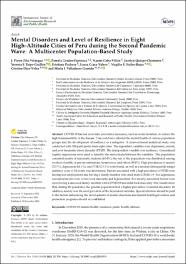Mostrar el registro sencillo del ítem
Mental Disorders and Level of Resilience in Eight High-Altitude Cities of Peru during the Second Pandemic Wave: A Multicenter Population-Based Study
| dc.contributor.author | Zila-Velasque, J Pierre | es_ES |
| dc.contributor.author | Grados-Espinoza, Pamela | es_ES |
| dc.contributor.author | Coba-Villan, Naomi | es_ES |
| dc.contributor.author | Quispe-Chamorro, Jocelyn | es_ES |
| dc.contributor.author | Taipe-Guillén, Yesenia F | es_ES |
| dc.contributor.author | Pacheco, Estefany | es_ES |
| dc.contributor.author | Ccasa-Valero, Laura | es_ES |
| dc.contributor.author | Failoc-Rojas, Virgilio E | es_ES |
| dc.contributor.author | Díaz-Vélez, Cristian | es_ES |
| dc.contributor.author | Valladares-Garrido, Mario J | es_ES |
| dc.date.accessioned | 2023-03-21T15:23:03Z | |
| dc.date.available | 2023-03-21T15:23:03Z | |
| dc.date.issued | 2022-12-28 | |
| dc.identifier.uri | https://hdl.handle.net/20.500.13053/8124 | |
| dc.description.abstract | COVID-19 has led us to take preventive measures, such as social isolation, to reduce the high transmissibility of the disease. This could have affected the mental health of various population groups and the development of resilience as a mitigator. A cross-sectional analytical study was conducted with 700 participants from eight cities. The dependent variables were depression, anxiety, and post-traumatic stress disorder (PTSD). The independent variable was resilience. Generalized logistic regressions were used to identify the associations between the variables. The population consisted mostly of university students (65.0%); the rest of the population was distributed among workers of public or private institutions, housewives, and others (35.0%). High prevalences of anxiety (72.7%), depression (64.1%), and PTSD (15.1%) were found, as well as a median (interquartile range) resilience score of 24 points was determined. Factors associated with a high prevalence of PTSD were having lost employment and having a family member who died from COVID-19. For depression, associated factors were severe food insecurity and hypersomnia. For anxiety, associated factors were were having a deceased family member with COVID-19 and mild food insecurity. Our results show that, during the pandemic, the general population had a higher prevalence of mental disorders. In addition, anxiety was the most prevalent of the dependent variables. Special attention should be paid to the factors influencing the development of mental disorders and mental health prevention and promotion programs should be established. | es_ES |
| dc.format | application/pdf | es_ES |
| dc.language.iso | eng | es_ES |
| dc.publisher | MDPI | es_ES |
| dc.rights | info:eu-repo/semantics/openAccess | es_ES |
| dc.rights.uri | https://creativecommons.org/licenses/by/4.0/ | es_ES |
| dc.subject | COVID-19; altitude; mental health; public health; resilience. | es_ES |
| dc.title | Mental Disorders and Level of Resilience in Eight High-Altitude Cities of Peru during the Second Pandemic Wave: A Multicenter Population-Based Study | es_ES |
| dc.type | info:eu-repo/semantics/article | es_ES |
| dc.identifier.doi | 10.3390/ijerph20010519 | es_ES |
| dc.type.version | info:eu-repo/semantics/publishedVersion | es_ES |
| dc.publisher.country | CH | es_ES |
| dc.subject.ocde | http://purl.org/pe-repo/ocde/ford#3.03.00 | es_ES |
Ficheros en el ítem
Este ítem aparece en la(s) siguiente(s) colección(es)
-
Web of Science (WOS) [236]


